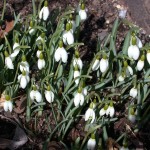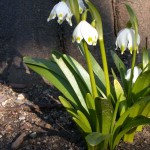Left:??The snowdrops (Galanthus nivalis) under the quince trees in Bonnefont Cloister bloom from February to March, while snowdrops in warmer climates may flower as early as January; right: the closely related spring snowflake (Leucojum vernum) blooms from March to May.
The winter-blooming snowdrop and spring snowflake appear so closely related that the great sixteenth-century herbalist John Gerard named them the Early Blooming Bulbous Violet and the Late Blooming Bulbous Violet. He also asserted that neither ancient writers nor his contemporaries had anything to say about the plants’ medicinal properties, and that both were cherished solely for their beauty and fragrance. Gerard regarded bulbous violets as garden plants introduced from Italy, although the snowdrop, which was to accumulate much lore in England, may be native there.
While the snowdrop became a Mary flower because of the white bloom and the association with the feast of her Purification, the flower???s association with purity was so far extended by the nineteenth century that Snowdrop Bands???chapters of a society for the encouragement of working-class girls to espouse chaste lives and avoid indecency???were organized. The journal of the society was called The Snowdrop, and members carried cards with a picture of a snowdrop and a promise to avoid indecent conversation and immoral literature. The groups held “brown suppers,” during which members potted up snowdrop bulbs, and “white suppers” when the snowdrops where in bloom (Paula Bartley, Prostitution: Prevention and Reform in England, 1860???1914).
I haven???t been able to find snowdrops in a Marian context in medieval art, but spring snowflakes do appear in representations of the Virgin by several German masters of the fifteenth century, including the famous Paradise Garden by the Master of the Upper Rhine in the St??del Museum in Frankfurt. Both the flowering lawn and the borders of the garden are filled with Mary plants. The spring snowflake appears below the hem of the Virgin???s blue robe, just to the right of the figure of the infant Jesus.
Both Roy Vickery in A Dictionary of Plant Lore (1995) and Richard Mabey in Flora Brittanica (1996) have collected testimony from twentieth-century informants in Great Britain confirming a popular superstition that snowdrops are an unlucky flower that can bring misfortune and death if picked and brought into the house, perhaps because they are often found growing in cemeteries and churchyards. Vickery cites Hilderic Friend, a Victorian authority on flower lore, who explains this association by the blossom???s resemblance to a shroud. Is it related to the fact that the snowdrop is as much a winter flower as a spring flower?
Does anyone know of any examples of this association of snowdrops with death in other European cultures?
???Deirdre Larkin
Tags: Galanthus, Leucojum, Mary plant, snowdrop, snowflake



May 4, 2009 at 4:51 pm
Hi Deidre,
I came across some information about snowdrops a while ago while researching my name. My name apparently means ???snowflower??? in Persian (I???m actually Turkish and Yugoslavian-the name must have come into Ottoman Turkish during the Ottoman Empire and finally into modern Turkish). I???m surprised that the name is Persian-are snowdrops and snowflakes even found in Iran and the rest of the Middle East?
Here???s the info I found:
According to legend, Snowdrops became the symbol of hope when Adam and Eve were expelled from the Garden of Eden. When Eve was about to give up hope that the cold winters would never end an angel appeared. This angel transformed some of the snowflakes into Snowdrop flowers to prove that winters do eventually give way to spring.
However, according to German legend, when God made all things he asked the snow to go to the flowers and get a little colour from them. All the flowers refused until he finally asked a Snowdrop to give a little of its colour. The Snowdrop agreed and as a regard the snow lets it bloom before all other flowers in spring.
In English folklore, Snowdrops are thought unlucky if brought into the house, representing death or parting from a loved one. A single Snowdrop blooming in the garden warns of impending disaster. Wearing a Snowdrop is said to bless you with pure thoughts. Bringing a Snowdrop indoors will lead to a death in the house. This led to the plant also being known as Death???s Flower.
Monks brought Snowdrop bulbs to England from Rome and planted them around their monasteries. Traditionally on Candlemas (2 February) the image of the Virgin Mary was taken down and a handful of Snowdrop blooms scattered in its place. Snowdrops were known to botanists of old as Bulbous Violets. Gerard???s ???Herbal??? refers to early-flowering Violets also being known as Snowdrops. In 1465 the Snowdrop was classed as an emmenagogue and as having digestive properties although it is not really used today as a herb.
May 4, 2009 at 4:52 pm
Yes, Berfu???
While Galanthus nivalis is native to Europe, there are both subspecies of G. nivalis and other distinct but closely-related species of snowdrop that are native both to Turkey and to the Caspian provinces of Iran. I haven???t found a Persian name for snowdrop, but the Illustrated Polyglottic Dictionary of Plant Names (A.K. Bedevian, 1936) lists SUT ??I?? as a Turkish common name. Galanthus elwesii, a large-flowered form still popular as a garden flower in the U.K. and the U.S., was discovered in Turkey by John Henry Elwes in 1874 and introduced into cultivation.
As to the snowdrop lore you uncovered: although many modern sources repeat the claim that snowdrops were brought to England by monks and that the blossoms were scattered in the place of the Virgin???s image on Candlemas, I haven???t been able to trace that usage back to a medieval source. We avoid relying on undocumented legends or lore in tracing the history of medieval species. However, the snowdrops???s association with misfortune and death has been recorded as an extant belief by contemporary oral historians of British plant lore such as Roy Vickery.